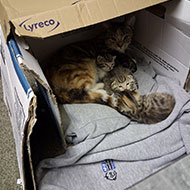The species has been found in the Florida Keys.
A new species of marine snail has been found living in the coral reefs of the Florida Keys.
The newly discovered gastropod, a bright yellow snail, has been called the Cayo margarita. It is named in honour of the late Jimmy Buffett’s song ‘Margaritaville’, which is often associated with the Florida Keys, as well as for its colour resembling the popular drink.
The Cayo margarita has been compared to its related species in Belize, Cayo galbinus. The name of its related species describes its more ‘greenish-yellow’ appearance.
Their genus, Cayo, is a Spanish word that refers to the small, low islands they were found on.
When the scientists first examined the snails’ different hues, they initially thought they were of the same species. However, after conducting DNA sequencing, it was discovered that they were very different.
The study has been led by Rüdiger Bieler, who is curator of invertebrates at the Field Museum in Chicago, alongside fellow Field Museum curator Petra Sierwald and researchers from Florida International University, Queensland Museum and Cape Breton University.
Despite studying invertebrates for four decades, Dr Bieler says the snails were so small and well-hidden that he had not encountered them before.
Marine snails, nicknamed ‘worm snails’, will spend most of their lives in one place. When a juvenile snail finds a suitable spot to live, they will settle down, cement their shell to the substrate and never move again.
Their shells grow as irregular tubes around their bodies, and they hunt by laying down mucus to trap plankton and detritus.
The research shows that these Cayo snails have key traits in common with another worm snail genus, Thylacodes. Despite being only distantly related, both genera include snails with brightly-coloured heads and tubular shells.
Bieler says that many snails are polychromatic, in that snails from across the same species can be very different colours. The colours are believed to confuse fish, by not giving them a clear target.
The study suggests that the yellows and greens of these Cayo snails could be warning colours, since they have metabolites in their mucus.
These metabolites, which are products of metabolism, seem to be used in the snails’ mucus to deter other organisms in the reefs from getting too close. It is believed that this, combined with their colouring, could be vital to their survival.
The discovery of these new species may highlight the biodiversity of coral reefs, which are considered to be at threat from global warming.
Rüdiger Bieler said: “There have been increases in global water temperatures, and some species can handle them much better than others,”
He added: “It's another indication that right under our noses, we have undescribed species. This is in snorkeling depth in a heavily touristed area, and we’re still finding new things all around us.”
The full study can be found in the journal PeerJ.
Image © R. Bieler






 The BSAVA has opened submissions for the BSAVA Clinical Research Abstracts 2026.
The BSAVA has opened submissions for the BSAVA Clinical Research Abstracts 2026.
